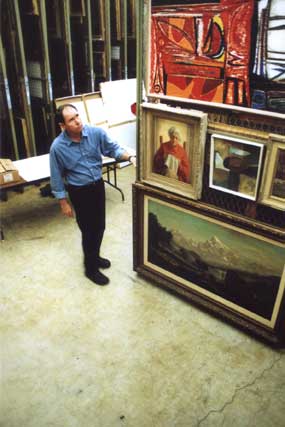Mansion Expansion

Image: Mansion Expansion::
October 3, 2001
E.B. and Margaret Crocker set sail many times to Europe, bringing home more than 900 paintings and 1,300 Master Drawings. Yet, almost 130 years later, much of that art is unseen.
“95 percent of all Crocker art is in storage,” said Rob Rough, director of marketing for the Crocker Art Museum. Rough said with the new expansion in progress, he hopes more art can be displayed.
“It would be wonderful if they had more space,” said Frank Fox, an undeclared graduate student at Sacramento State.
Nestled between apartment buildings, the Crocker is not just another downtown Victorian building; it is a historic treasure, founded in 1885, containing works from the 15th century through contemporary periods. The Crocker?s collection includes works from Europe, North America and Asia. The museum also offers special exhibitions, events and educational programs.
“The California Art Collection makes the Crocker important to our state,” Rough said. “You can see how California was becoming a state in viewing the art.”
Space is limited, but the spirit of the museum is large. Upon entering the Stoke-on-Trent tile imported from England in the 1870s, many tourists may feel a sense of utter grandness. The 20-foot high Victorian ceilings, dual winding mahogany stairways and Queen Anne Chairs are what tourists will notice upon entering this historical treasure.
“Once a new Crocker customer enters, they almost always return as frequent Crocker visitors,” Rough said. He said even the doorknobs are a must-see at the Crocker, containing original images of busts from the Victorian era.
In August 2000, the expansion of the Crocker became one of the most desired architectural projects both in the United States and abroad. New York?s Gwathmey Siegel & Associates Architects were selected out of 30 firms that submitted requests for qualifications to begin designs for the expansion of the Crocker.
“The museum is undergoing master planning for expansion,” said Lial Jones, director of the museum. Jones said there was a donation of $16 million in what she called a “gift in confidence,” money given to Crocker to help with any future plans with no strings attached.
Jones, who is now helping paint a new work for the Crocker, came to the museum two years ago from Delaware. She worked as Director of the Delaware Art Museum and has been working in the museum field for 20 years.
“It is important to me to provide a variety of exhibitions,” Jones said. She said she wants to make the museum more regional and provide the museum with more educational programs that would help inspire young people to develop an appreciation for the arts.
“Artists reflect the society in which they live,” Jones said. “They bring a variety of expression, and make us think about things we wouldn’t normally think about.”
The next step on her to-do list is to work on master planning for new space, not only for regular exhibits, but also for art classes and touring art exhibits. Currently there are little more than 3,000 square feet for touring shows, and most shows require at least 12,000 square feet, leaving many unable to even consider coming to the Crocker.
While Jones admits the Crocker is a work in progress, she hopes she has brought an excited feeling to it and hopes that with many of the new programs and exhibitions, she will be able to raise more money for the expansion. She said she wants to get the community involved in art, no matter what age or background.
E.B. and Margaret Crocker had a passion for art and so does Jones. She and many members of the Crocker family want to expose others to the exciting and enriching life of art. The Crockers started this trend in educating the public, and Jones is here to help expand that dream.
“The Crocker Art Museum was a jewel when I got here, but somewhat of a dusty one,” Jones said. “I simply want to make it home for everyone to call their own.”




























































































































